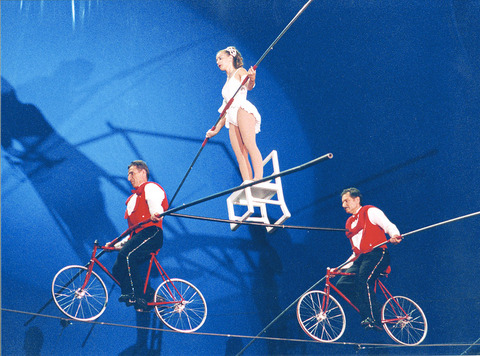Has there ever been such a smorgasbord of circuses incorporating so many styles from so many different countries in Taiwan at one time? The Great Moscow Circus has been touring the island since the beginning of this month. At the end of October, Spotlight on New Circus will showcase various contemporary circuses and experimental theater groups in the square between the National Theater and National Concert Hall. And beginning tomorrow, the Flying Wallendas will bring their version of circus to Asia for the first time to dazzle and delight audiences with some acrobatic drama and tightrope titillation.
The Wallenda family has a rich history of entertainment that dates back to 1780 when it wandered Europe as a traveling circus troupe composed of acrobats, jugglers, clowns, aerialists and animal trainers.
By the early 20th century, the Great Wallendas — as they were known at the time — had established themselves as one of the preeminent circus performance troupes touring the world with and headlining circus acts such as Ringling Brothers and Barnum and Bailey. Once in Akron, Ohio, the wire slipped while they were performing and all four members fell to the wire, yet they were relatively unhurt. The next day a headline in a local paper proclaimed them “The Flying Wallendas,” and the name has stuck ever since.

PHOTOS COURTESY OF KUANG HONG ARTS
In 1947, Karl Wallenda began building a circus of his own. It was also at this time that he created his death-defying Seven-Person Pyramid consisting of four men standing on a wire 10.5m in the air, two pairs yoked together by shoulder bars. On top of them stood two more men and at the pinnacle was a woman sitting and then standing on a chair. This feat, like all other acts on the tightrope, is performed without using any kind of safety net.
Tino Wallenda, who now leads the troupe, started out on the wire at the age of seven when his grandfather took him into his backyard, put a balance-pole in his hands, taught him how to place his feet, control his body and where to focus his eyes. By the age of 17, he was a full-fledged member of the troupe.
When he was young, all he could think about was performing and didn't think too much about the tradition that his grandfather had established.

“The legacy that it involved didn't hit me until later on. It's like my kids right now: When you are younger you only want to perform. But now that I'm getting older, I've begun to realize the significance [of what I do],” he said in an interview with the Taipei Times.
The lineup of top-notch performers coming to Taipei will be overseen by Charley van Buskirk — a ring master complete with handle-bar mustache and black top hat — and includes trapeze artists, aerialists, trampoline acts along with jugglers and comedy clowns that perform on and off the high wire. A highlight of the show is the man who sets himself on fire 12m in the air and then dives into a small air mattress. And of course no Flying Wallenda performance would be complete without their Guinness World Record seven-person pyramid.
Tragedy strikes
The success of the family has also been marked by tragedy, most famously in 1962 when a pyramid collapsed in Detroit, leaving two performers dead and Mario Wallenda — Tino's uncle — paralyzed from the waste down. Family patriarch Karl Wallenda died in a 1978 fall from the wire in Puerto Rico.
Tino Wallenda searches carefully for an answer before commenting on these events.
"We learn from these experiences," he muses. "But we are also very strong — like my grandfather was — and there is a perfect saying: the show must go on."
But the circus itself is under threat.
"The level of circus has in some ways diminished because of the commercialism that is used. And so sometimes people have gone to see what they thought would be a quality circus and it was more of a promotional package that was sold to them and they got less than what they deserved. And so people get disappointed and don't want to come back to the circus," Wallenda said.
Compounding this was the development of the animal rights movement in the 1960s, which resulted in traditional circuses losing much of their appeal. As a consequence, circus performances began a gradual decline up until the 1970s when a new kind of circus began to emerge. Beginning at the end of that experimental decade, a new generation of circuses known as the New Circus — or Cirque Nouveau — began appearing in France.
New Circus
The new circus — most recently popularized by troupes such as Cirque du Soleil — features highly physical activities and no animal tricks. Known also as physical theater, many of these new circus groups have vague narratives that are closer to theater than the entertainment found in the traditional circuses. The island will have a chance to see this newer kind of circus performance beginning Oct. 27 with a festival called Spotlight on New Theater.
"The new circus in some ways feels that the traditional circus is inferior. But I always think that there is going to be room for the traditional circus," Wallenda said when asked about the differences between the two styles.
"But the thing about the new circus that is good is that it's brought a new interest to circus [overall]," he added.
Andrew Guild, a producer from the Great Moscow Circus agrees. "Today, [the] circus relies much more on human skills," he said in an email interview. "Circus is now an art form — in Russia it is likened to opera and ballet," he added.
The Great Moscow Circus has some of the world's best performers and, like the new theater, also has a line-up of world-class athletes.
"Some of our artists have performed at the Olympics," he said.
But their Taiwan performances have not been without controversy. Last week a conservation group called on the legislature to amend the law to ban animal shows in circuses.
But Guild pointed out that even though watching animals in circuses have gone out of vogue in certain quarters, "the people of Taiwan want to see performing animals." Guild is also at pains to express that animal cruelty is not something his circus condones.
"[The animals] have grown up in the circus. They are well cared for and loved by their trainers," he said.
Though the Flying Wallendas typically incorporate animals into their show, there will be none for their Taipei performance. Wallenda says this decision has nothing to do with activism, but rather is due to the logistics of getting them over to Taiwan.

That US assistance was a model for Taiwan’s spectacular development success was early recognized by policymakers and analysts. In a report to the US Congress for the fiscal year 1962, former President John F. Kennedy noted Taiwan’s “rapid economic growth,” was “producing a substantial net gain in living.” Kennedy had a stake in Taiwan’s achievements and the US’ official development assistance (ODA) in general: In September 1961, his entreaty to make the 1960s a “decade of development,” and an accompanying proposal for dedicated legislation to this end, had been formalized by congressional passage of the Foreign Assistance Act. Two

March 31 to April 6 On May 13, 1950, National Taiwan University Hospital otolaryngologist Su You-peng (蘇友鵬) was summoned to the director’s office. He thought someone had complained about him practicing the violin at night, but when he entered the room, he knew something was terribly wrong. He saw several burly men who appeared to be government secret agents, and three other resident doctors: internist Hsu Chiang (許強), dermatologist Hu Pao-chen (胡寶珍) and ophthalmologist Hu Hsin-lin (胡鑫麟). They were handcuffed, herded onto two jeeps and taken to the Secrecy Bureau (保密局) for questioning. Su was still in his doctor’s robes at

Last week the Democratic Progressive Party (DPP) said that the budget cuts voted for by the China-aligned parties in the legislature, are intended to force the DPP to hike electricity rates. The public would then blame it for the rate hike. It’s fairly clear that the first part of that is correct. Slashing the budget of state-run Taiwan Power Co (Taipower, 台電) is a move intended to cause discontent with the DPP when electricity rates go up. Taipower’s debt, NT$422.9 billion (US$12.78 billion), is one of the numerous permanent crises created by the nation’s construction-industrial state and the developmentalist mentality it

Experts say that the devastating earthquake in Myanmar on Friday was likely the strongest to hit the country in decades, with disaster modeling suggesting thousands could be dead. Automatic assessments from the US Geological Survey (USGS) said the shallow 7.7-magnitude quake northwest of the central Myanmar city of Sagaing triggered a red alert for shaking-related fatalities and economic losses. “High casualties and extensive damage are probable and the disaster is likely widespread,” it said, locating the epicentre near the central Myanmar city of Mandalay, home to more than a million people. Myanmar’s ruling junta said on Saturday morning that the number killed had